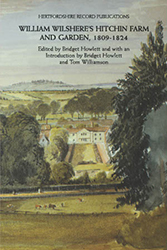
Volume XXXIX:
William Wilshere’s Hitchin Farm and Garden, 1809-1824
William Wilshere (1754-1824) was a Hitchin lawyer. In his later years he farmed about 120 acres of land, mainly to the east of the town of Hitchin, and mainly cultivated for arable crops. He kept several ‘Farm and Gardening Memoranda’, the two books covering the years 1809 to 1824 form this volume. They constitute an unusual and important source for students of both agricultural and garden history: indeed, few surviving journals or notebooks from the eighteenth and nineteenth centuries manage to include an account of both the farming and the horticultural activities of a particular individual. This volume includes plans showing land occupied by Wilshere drawn up in c1808 and 1818 which, together with other evidence, allows the activities described to be placed within a secure spatial frame.
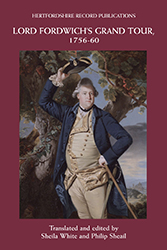
Volume XXXI:
Lord Fordwich's Grand Tour, 1756-60
In January 1757 George Nassau Clavering-Cowper left England to undertake his Grand Tour of Europe. Styled Viscount Fordwich, he was 18 years old and heir to an earldom. In most cases a young gentleman’s Grand Tour took about a year, Lord Fordwich’s lasted three. The first two years were spent at the renowned Academy in Lausanne. Then in April 1759 he set out on a trip which took him through the Rhineland, Bavaria and Austria, then south to Italy. While in Florence he fell passionately in love with a beautiful Florentine lady known as the Marchesa Corsi. His passion for the lady eventually burnt itself out, but he remained in Florence until his death in 1789.
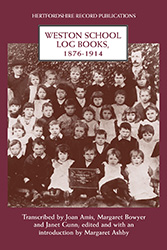
Volume XXX:
Weston School Log Books, 1876-1914
Weston National (Church of England) School was founded in 1847, when the first pupils were taught in a house near the church. By 1856 a purpose-built school was in operation, with separate provision for infants and older children. The head-teacher was required to keep registers and daily log books. The latter recorded attendance, lessons taught, examinations and any other matters relevant to the children's education.
The transcriptions in this volume begin with the earliest surviving log-book, from 29 May 1876 and continue to the outbreak of the First World War in August 1914. The entries reveal vivid glimpses of school and village life over nearly 40 years: the dedication of staff; the pupil-teachers, without whom the school could not function properly; the generosity of school visitors in providing treats and prizes; the hardships imposed by bitter winter weather; the suffering caused by illnesses for which there was then no known cure; and the occasional mystery, such as the events of winter 1882-3.
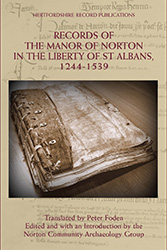
Volume XXIX:
St Albans wills, inventories and probate accounts, 1600-1615, edited by Pat Howe, et al
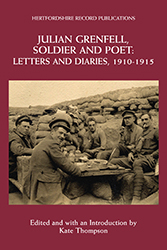
Volume XX:
Julian Grenfell: soldier and poet: letters and diaries: 1910-1915
Julian Henry Francis Grenfell joined the army in 1910, having been educated at Eton and Balliol College, Oxford. He served with his regiment in India and South Africa, until, on the outbreak of war in 1914, he was sent to France as part of the British Expeditionary Force. He became noted for his courage and was posthumously awarded the DSO. At Ypres, in May 1915, he was wounded by a shell splinter which penetrated his brain. Despite two operations, he did not survive. A minor First World War poet, his best known poem 'Into Battle' was published in The Times a day after his death.
Throughout his army service Julian wrote long, descriptive letters to his family and friends. These letters, which are published here in their entirety, add immeasurably to the body of knowledge of the First World War, a conflict that continues to fascinate and appal in equal measure.
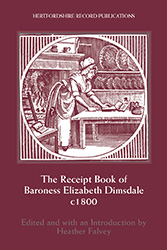
Volume XXVIII:
The Receipt Book of Baroness Elizabeth Dimsdale (c.1800)
After 1800, during her sixties/seventies, Baroness Elizabeth Dimsdale copied around 700 recipes and more than 80 household hints into a book. At the top of many of these items she indicated their provenance Many of the recipes are similar to those published in other cookery books in circulation during the later eighteenth century, but the ingredients and methods differ.
This volume provides a transcript of all of these ‘receipts’ and household hints. The introduction considers who Elizabeth was and what her book reveals about her life and connections in Hertfordshire. There is an extensive glossary of ingredients and utensils. The appendices include a list giving the original order of the recipes; mini-biographies of the donors who can be identified; and Elizabeth’s will.
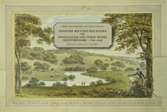
Volume XXVII:
Humphry Repton’s Red Books for Panshanger and Tewin Water
The publication of this full-colour edition brings into the public domain rare examples of Repton's design skills. As most of his surviving Red Books are in private ownership, this volume will be of great interest not only to historians of Hertfordshire but also to garden historians everywhere. The sketches in Repton's original Red Books comprise watercolours with overlaid flaps: the flap is closed to show the 'before' scene and lifted to reveal the 'after' scene. Due to constraints of production costs, rather than reproduce the flaps, this edition presents full-colour reproductions of each sketch both 'before' and 'after'. The Introduction by Twigs Way outlines Repton’s work, his design principles and the practical application of them.
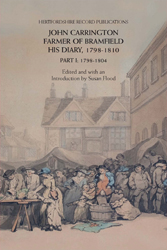
Volume XXVI:
John Carrington, farmer of Bramfield, his diary, 1798-1810, part I, 1798-1804
This new edition will, for the first time, contain the whole text of John's diary and writings, 1738‐1810 (in two volumes) and the diary of John's son Jack who continued his father's diary until 1812. With an historical introduction, appendices that include biographies of local persons, a glossary and full indexes of names, places and subjects, this illustrated publication will make John's writings on local and national life fully accessible to all.
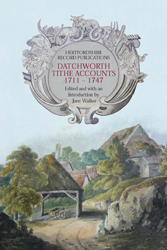
Volume XXV:
Datchworth Tithe Accounts, 1711 to 1747
Recent volumes from the society
Now Published
- Volume XL, The Poor, the Sick and the Stranger in Hertfordshire: A Selection of Settlement Examinations and Removals, 1697-1898
- Volume XXXIX, William Wilshere’s Hitchin Farm and Garden 1809-1824, edited by Bridget Howlett
- Volume XXXVIII, Berkhamsted St Peter Churchwardens' Accounts, c.1584-1660
- VOLUME XXXIII, John Carrington, farmer of Bramfield, his diary, 1798-1810, volume 2, 1805-1810 and John Carrington junior's diary, May 1810-December 1812, edited by Susan Flood
- Volume XXXVII, Ashwell overseers’ accounts, 1676-1722, edited by David Short
- Volume XXXVI, The Third Earl Cowper and his Florentine Household, 1760–90, edited by Philip Sheail
- Volume XXXV, Governors’ Journals, Hertford Gaol, 1834-1844, edited by Eileen Wallace
- Special Publication, Hertfordshire Population Statistics 1563-1801 (2nd edition)